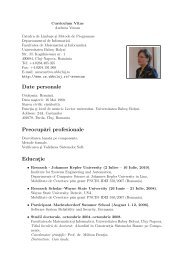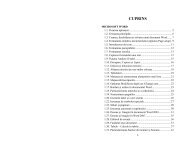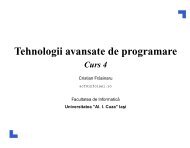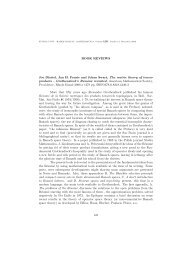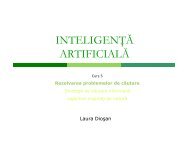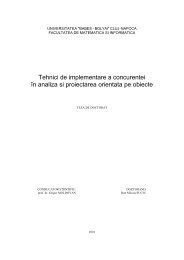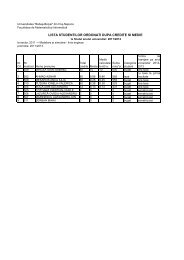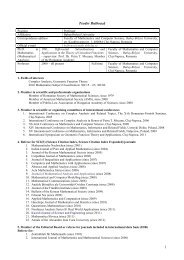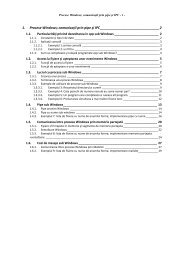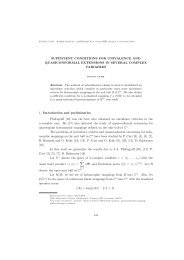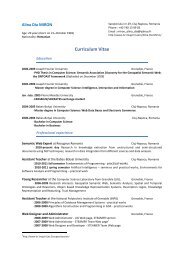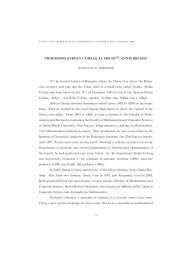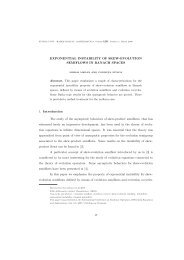CONTENTS
CONTENTS
CONTENTS
Create successful ePaper yourself
Turn your PDF publications into a flip-book with our unique Google optimized e-Paper software.
SKEPTICAL REASONING IN CONSTRAINED DEFAULT LOGIC 233<br />
Definition 4.2. (semantics of a skeptical constrained default sequent)<br />
The skeptical constrained default sequent: Constr; (W, D); Res ↦−→ U is true if ∨U<br />
belongs to all constrained default extensions of the theory (W, D), that satisfy the<br />
constraints Constr and Res contains the residues of the applied defaults.<br />
Definition 4.3. For a default theory ∆ the skeptical constrained default axiomatic<br />
system is: Skcons cons<br />
∆ = (Σcons,<br />
F , Acons,<br />
Rcons<br />
Sk∆ Sk∆ Sk∆ Sk∆ ).<br />
Σcons cons<br />
- the alphabet, F = all classical sequents/anti-sequents enhanced with residues<br />
Sk∆ Sk∆<br />
and all skeptical constrained default sequents.<br />
Acons - the axioms (all classical basic sequents and basic anti-sequents).<br />
Sk∆<br />
Rcons Sk∆ = {S1, S2, S3} ∪ {Re1, Re2, Re3, Re4} ∪ {classical sequent/anti-sequent rules}<br />
Based on Theorem 2.1 we propose the sequent rules for constrained default logic:<br />
, where ConstrM = {α|Mα ∈ Constr}<br />
(S1) ConstrM ∪W ⇒false W ∪Res ⇒U<br />
Constr;(W,D);Res↦−→U<br />
(S2)<br />
(S3)<br />
Constr∪{M(β∧γ)};(W,D);Res∪{ α<br />
γ } ↦−→U Constr∪{L¬(β∧γ)};(W,D);Res ↦−→U<br />
Constr;(W,D∪{ α:β<br />
γ });Res ↦−→U<br />
W ∪{β∧γ| α:β<br />
γ ∈D}⇒δ<br />
Constr∪{Lδ};(W,D);Res ↦−→U<br />
S1 verifies if the reasoning context (obtained using the set of applied defaults) is<br />
consistent (left premise) and if ∨U is derivable from the set of facts and the corre-<br />
sponding residues (right premise). Using S2 we search exhaustively if ∨U is a skeptical<br />
is applied (left premise) and that the<br />
consequence of the theory ∆ considering that α:β<br />
γ<br />
default α:β<br />
γ is not applied (right premise). The rule S3 checks if there are constrained<br />
extensions that satisfy the constraint Lδ.<br />
Theorem 4.1. The skeptical constrained default sequent calculus is sound and<br />
complete: a skeptical constrained sequent is true if and only if it can be reduced to<br />
classical basic sequents and basic anti-sequents using R cons<br />
Sk∆ .<br />
Consequence: A formula X is a skeptical constrained default consequence of<br />
the default theory (D, W ) if and only if the skeptical constrained default sequent<br />
∅; (W, D); ∅ ↦−→ X is true.<br />
Example 4.1. The default theory ∆ = (D, W ), D =<br />
Q:P<br />
S<br />
, S:T<br />
T<br />
, R:¬P<br />
H<br />
<br />
H:T , T ,<br />
W = {Q, R} has two constrained default extensions: (E1, C1) = (T h({Q, R, S, T }),<br />
T h({Q, R, S, T, P })) and (E2, C2) = (T h({Q, R, H, T }), T h({Q, R, H, T, ¬P })).<br />
We check if T is a skeptical constrained default consequence of the theory ∆:<br />
Π1:{M(P ∧S)};({Q,R},{d2,d3,d4});{ Q<br />
S } ↦−→T Π2:{L¬(P ∧S)};({Q,R},{d2,d3,d4});∅ ↦−→T<br />
∅;({Q,R},{d1= Q:P S:T R:¬P H:T<br />
S ,d2= T ,d3= H ,d4= T });∅ ↦−→T<br />
(S2)<br />
By applying the rule (S2), the default sequent Π1 is reduced to Π11 and Π12:<br />
Π11:{M(P ∧S),M T };({Q,R},{d3,d4});{ Q<br />
S<br />
Π1:{M(P ∧S)};({Q,R},{d2= S:T<br />
T<br />
, S<br />
T } ↦−→T Π12:{M(P ∧S),L¬T };({Q,R},{d3,d4});{ Q<br />
S } ↦−→T<br />
,d3,d4});{ Q<br />
S } ↦−→T<br />
The default sequent Π11 is a true default sequent as follows:<br />
{Q,R,P ∧S,T }⇒false<br />
.<br />
{Q,R, Q<br />
S , S (Re2)<br />
T }⇒T<br />
Π11:{M(P ∧S),M T };({Q,R},{d3,d4});{ Q<br />
S<br />
, S<br />
T } ↦−→T (S1)



